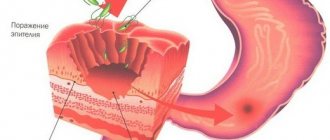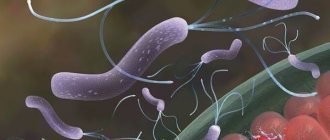Duodenal cancer is considered a rare disease of the gastrointestinal tract. This disease is equally often diagnosed in both sexes over the age of 50 years. The origin of cancer is difficult to identify at the last stage, since the germination and spread of the tumor to other organs and mucous membranes leads to the formation of a neoplasm consisting of the same tissue.
A malignant tumor of the duodenum is more often diagnosed in people over 50 years of age.
Causes of oncology
- Viruses. Some of them are capable of changing the cellular genome.
- Carcinogens. There are substances that can change cellular DNA.
- Poor nutrition. Eating overcooked, fatty, spicy foods in large quantities irritates the lining in the stomach, which leads to the formation of a tumor.
- X-ray radiation. Capable of changing cell structure.
- Smoking. Resins that penetrate the body are strong carcinogens.
- Decreased immunity. If the body's protective functions are weakened, it is difficult for it to resist various diseases. If the immune system is normal, lymphocytes are able to destroy cancer cells, preventing them from multiplying further.
In addition, there are a number of diseases that provoke
Stomach ulcers and other diseases can contribute to the development of gastrointestinal cancer
the formation of malignant pathological processes in the gastrointestinal tract. Among them:
- stomach ulcer;
- erosive processes in the stomach;
- polyps (benign growths can develop into a malignant tumor);
- benign tumors of the duodenum.
Occurrence and features
There are no signs that duodenal cancer is associated with an ulcer of this organ or the development of cholelithiasis, since experts have not collected enough data on this. For the most part, duodenal tumors arise from the epithelium of the intestinal glands; the outer layers of the organ rarely undergo changes.
Tumors of the duodenum are divided into two types:
- exophytic, in which the tumor grows into the lumen of the organ, causing obstruction;
- endophytic, making its way to the surface of the organ and further into neighboring tissues.
Cancer can either strive to occupy the maximum amount of space along one of the walls or encircle the intestine around the circumference, but in all cases the surface of the tumor partially ulcerates and bleeds. There are three main locations of tumors in the duodenum:
- Periampullary cancer, arising in the descending region closest to the peripapillary region. This arrangement is typical for 80% of all reported cases. This is explained by constant irritation of the internal epithelium lining the walls of the duct, a large amount of bile and gastric juice.
- Suprapapillary cancer, which occurs in the upper horizontal part of the organ, accounts for up to 15-17% of duodenal cancers.
- Prejejunal cancer, which is the rarest, begins to grow in the lower horizontal part of the duodenum.
Symptoms
There are symptoms that may indicate the development of cancer at an early stage:
- frequent vomiting, heartburn;
- noticeable weight loss without changing diet;
- decreased body tone;
- pale skin;
- heaviness in the stomach, lack of appetite;
- depressive states;
- sleep disturbances.
The above signs do not always confirm that the patient has duodenal cancer, but it is advisable to consult a specialist and, if necessary, undergo an examination. Symptoms of a cancer tumor in the last stages are:
- severe weight loss;
- anemia;
- regular severe pain that can radiate to the lumbar region;
- the appearance of bleeding in the intestines and stomach (stool becomes black, vomit becomes dark);
- weakness, noticeable paleness of the skin.
Diagnostics
In order to begin adequate treatment in a timely manner, it is necessary to conduct a thorough diagnosis, which includes instrumental and laboratory methods.
- Collection of life history and concomitant pathologies. Visual examination of the patient. Palpation of the abdomen in the area of the stomach, liver. Important clinical complaints are pain, vomiting, progressive weight loss, decreased appetite, and enlarged regional lymph nodes.
- Laboratory testing, which includes a general blood test, biochemical blood test, general urine test, tumor marker, stool test.
- Instrumental examination.
Instrumental research is of greatest importance. An esophagogastroduodenoscopy (EGDS) is performed - a procedure during which a specialist can determine the condition of the stomach, esophagus, duodenum, and bile duct. During this procedure, tissue is also taken for biochemical analysis.
The next diagnostic examination will be a chest x-ray and contrast x-ray of the stomach and duodenum.
Ultrasound, computed tomography, and magnetic resonance imaging are also performed. In parallel with this, a mandatory examination is carried out by all specialists, including a therapist.
Signs of peripapillary cancer
At an early stage, symptoms hardly appear. Such manifestations are typical for later periods. In particular, the flow of bile secretions into the intestines becomes difficult. The following symptoms occur: pain in the hypochondrium, vomiting, loss of appetite. The development of a malignant tumor provokes inflammation of the pancreas tissue, which causes pancreatitis.
Symptoms of a malignant process in the horizontal sections of the duodenum:
- feeling of heaviness in the abdominal cavity;
- nausea;
- painful sensations in the hypochondrium;
- flatulence;
- urge to vomit;
- severe heartburn, the appearance of belching, gastric secretion of increased acidity.
In this case, initially the formations cannot be detected by palpation (the first stages of development). If oncology develops at the bottom of the horizontal section of the duodenum, then it can be detected during palpation. Patients also experience decreased appetite, weakness, anemia, and possible internal bleeding.
Symptoms
The presence of provocative signs significantly increases the risk of the first symptoms of a malignant neoplasm. Some of them can be easily eliminated by working on yourself. Maintaining a healthy lifestyle, regular exercise, exercise, and avoiding infectious inflammatory processes help strengthen the immune system, which, in turn, stimulates the body to increase resistance to the development of cancerous tumors.
The first symptoms of duodenal cancer
The early stage of cancer development is quite difficult to diagnose, since the symptoms are mild. Often patients learn about a terrible diagnosis by chance, during a routine medical examination, ultrasound or FGDS.
Procedure for conducting FGDS
Important! If a person has a hereditary predisposition to cancer, he is included in the risk group, the manifestation of the first symptoms should alert him and prompt him to conduct a full course of examination.
The most characteristic symptom in this case is a dull pain in the stomach area, just below, which is more pronounced at night. It often occurs when a person is hungry. At the same time, there is a feeling of heaviness and petrification of the organ.
With the inevitable growth of a malignant neoplasm, the functioning of the gallbladder is disrupted, and bile and ingested food cannot pass normally into the small intestine. During this period, the patient may feel the first symptoms of duodenal cancer:
- there is a feeling of heaviness, nausea, constant belching and heartburn haunt you;
- an aching painful state of a permanent nature can be traced;
- some time after eating, the contents of the stomach spontaneously pour out;
- poor appetite contributes to a sharp weight loss of the patient.
Symptoms of duodenal cancer
Similar symptoms may characterize other diseases of the digestive system. Therefore, based only on them, the doctor cannot make a clear diagnosis.
General symptoms of cancer
With duodenal cancer, the patient experiences complete intoxication of the body, characterized by general symptoms. They are observed when malignant tumors affect various systems and organs. The intensity and severity manifests itself depending on the size of the neoplasm, the stage of the lesion and other signs.
The general symptoms are as follows:
- The patient feels constant malaise, weakness, and apathy to the events happening around him. He experiences depression and outbursts of aggression.
- Frequent dizziness and headaches provoke a fear of being alone, the patient suffers from insomnia and nightmares.
- A change in the shade of the skin is noticed (the face turns pale, sometimes a bluish tint or yellowness appears).
- Lack of appetite sometimes provokes the development of anorexia.
- There is a disruption in the functioning of the “internal clock”. A person may not sleep a wink all night, and during the day an irresistible drowsiness sets in.
- There is dryness in the mouth and nose, the patient blinks frequently, trying to involuntarily moisten the eyes by naturally closing the eyelids.
- Sweating increases at night.
- Body temperature constantly remains at 37 degrees (sometimes reaches 39).
- Constant nausea provokes bouts of vomiting.
- Due to decreased immunity, the patient often suffers from infectious diseases.
- Sometimes anemia of the upper and lower extremities is noticed.
Stages of bowel cancer
Attention! The symptoms of duodenal cancer largely depend on the location of the tumor node. When it grows in the lumen of the small intestine, intestinal obstruction is observed; if its growth is directed outward, bleeding is a characteristic symptom.
In order for the doctor to make an accurate diagnosis, a complete diagnostic examination of the patient for the presence of cancer cells is recommended. The first symptoms of cancer that occur in a person should not be ignored, especially if he is at risk. Therefore, you need to carefully monitor your health and undergo the necessary examinations in a timely manner. How to give a child an enema, you will find the answer in the link.
Treatment
Surgical Treatment Options
There are three types of surgical interventions. The surgeon chooses one of them based on the type and location of the cancerous tumor in the intestine. If the patient has a small tumor at the top of the horizontal area of the duodenum, it is necessary to resort to a circular resection of the affected part of the intestine. Then patency should be restored using anastomosis or repeated intervention should be performed. With the infrapapillary type of the disease, resection of the lower duodenum can be done.
The most difficult interventions are for the development of peripapillary cancer. If the tumor is localized in the area of the duodenal papilla, the affected area of the intestine is removed. In addition, a lesion near the papilla requires removal of the head of the pancreas itself and part of the duct.
Chemotherapy
After surgery, chemotherapy is prescribed. This involves using powerful medications to suppress cells that are dividing rapidly. Such remedies help eliminate the remaining pathogenic cancer cells.
Classification
Malignant disease is conventionally divided into several types. The classification of pathology consists of the following criteria and varieties:
- by growth form - exophytic and endophytic formations;
- according to microscopic characteristics - adenocarcinoma and signet ring cell carcinoma;
- according to the degree of development - primary and secondary;
- by location - the descending part of the peripapillary region, the upper horizontal surface of the intestine or the horizontal surface of the organ.
Metastases
Duodenal cancer in most cases metastasizes in the late stages. Distant processes are diagnosed in people with large primary pathology, often in the liver. Initially, metastases affect the nearest lymph nodes, liver, pancreas, peritoneum, etc. Metastasis of the head of the pancreas can provoke the development of jaundice. Metastases can reach large sizes that exceed the primary cancer, which is often diagnosed as a primary tumor of the head.
Forecast
Experts are studying how long people live after being diagnosed. Duodenal cancer offers a favorable prognosis if the disease is detected early. It all depends on how many months have passed since the onset of symptoms. Timely diagnosis allows treatment to be carried out as soon as possible and the occurrence of complications and metastases to be prevented. If metastasis occurs (the formation of additional foci of cancer cells that have moved from the place where the tumor appeared to nearby distant tissues and organs), the prognosis for the patient worsens . In such cases, there is a high probability that duodenal cancer will be fatal.
Disease prevention
There are no specific preventive measures that help prevent duodenal cancer. You should follow simple rules that will help a person stay healthy for as long as possible:
- refusal of alcoholic beverages and tobacco;
- proper nutrition (refusal of excessive consumption of salty, pickled, overcooked foods, smoked foods; transition to a balanced diet);
- timely treatment of diseases that can cause intestinal cancer (for example, adenomas, papillomas);
- regular examinations by a gastroenterologist for people over fifty years of age who have stomach and intestinal ailments.
Duodenal cancer. survival
Duodenal cancer is a malignant lesion of an organ, characterized by tumor growth at the site of localization, metastasis to other foci, and impairment of functional abilities.
Anatomy and functions
The duodenum is part of the digestive tube, it follows the stomach and is the initial section of the small intestine.
It consists of the following parts:
- Duodenal bulb.
- The top or horizontal part.
- Descending part.
- The ascending part.
A pathological process can form in each of these departments. The duodenum is a hollow organ with a tube structure, shaped like a horseshoe.
It fits tightly around the head of the pancreas and borders on other organs: the stomach, liver, intestines, large lymphatic and blood vessels.
Has main functions:
It comes down to processing the bolus of food and preparing it for further movement from the acidic environment of the stomach to the alkaline environment of the intestines.
The secretion of the pancreas and liver opens into its lumen. Enzymes break down food into proteins, fats, carbohydrates, and microelements, which facilitates their absorption.
Causes of the disease
In the modern world of medicine, there is debate about establishing the cause of the disease. The exact etiological factor has not been fully established. Background processes, precancerous conditions and harmful factors that can cause the development of the disease are identified.
These include:
- Diseases of the duodenum with a chronic course.
Scientists have proven that cancer does not develop on unchanged mucosa. Oncology is always preceded by damage and dysplasia. Dysplasia develops against the background of chronic duodenitis and duodenal ulcers. The risk increases if necessary treatment is not given.
- The presence of polypous damage to the mucous layer.
Diffuse polyposis often occurs in relatives across generations. It affects both the large and small intestines, the duodenum is no exception. Over a long period of time, polyps can develop into malignant tumors.
- The presence of benign tumors.
With the aggressive action of pathological factors on a benign tumor, it can mutate and develop into cancer.
- Genetics and hereditary factors play a significant role.
Duodenal cancer often occurs within the same family between blood relatives of different generations. The leading role here is given to the accumulation of a gene that carries information about cancer.
- Irrational food intake or consumption of low-quality products.
Recently, diet has an active influence on the development of gastrointestinal diseases. People began to increasingly consume fried, spicy, sour, fast food, quick snacks, and genetically modified foods.
All this has an extremely detrimental effect on the human body. The patient does not fully receive the necessary substances. There is an overabundance of harmful chemical elements, weakened immunity, and the development of oncology.
- Drug poisoning.
- In almost 70% of cases, cancer occurs due to the consumption of alcohol and smoking - a scientifically proven fact.
- Damage to Helicobacter pylori infection.
Some groups of drugs, such as hormones, non-steroidal anti-inflammatory drugs, antibiotics, can cause damage to the mucous membrane of the stomach and duodenum.
With prolonged use, the processes become irreversible, dysplasia and cancer appear. It is important to consult with specialists when using any medications, because many drugs have side effects and unwanted reactions.
- The environmental factor and harmful working conditions cannot be denied.
Chemicals tend to accumulate in the body. After this, they disrupt metabolic processes, causing various diseases, including cancer.
- Intestinal infections and invasions.
The disease develops against the background of hidden intestinal infections and helminthic lesions.
- A huge problem of our time is a sedentary lifestyle, physical inactivity.
Survival rate for duodenal cancer
In order to estimate survival, you need to know the stages of the process; at each stage, survival varies.
With it, the tumor has a small size of up to 2 cm. It is located on the superficial layers, does not grow in depth, and does not have metastases. It may not manifest itself clinically; for this reason, at an early stage the tumor is difficult to diagnose.
If you undergo annual preventive examinations, the tumor is detected at this stage. The survival rate for complete treatment of colon cancer is 90-98%. People are completely cured of the disease, there is no relapse. The prognosis for life and health is favorable.
The lesion becomes large in size, up to 5 cm. It grows into the submucosal layers, there is no metastasis. Early symptoms may appear: nausea, pain, heaviness in the epigastrium.
It is well diagnosed and subject to surgical and combined treatment. With timely treatment, survival rate over 5 years is high - 70-90%. Relapse occurs rarely, the prognosis for life and health is favorable.
More difficult. The tumor reaches large sizes. Affects all layers of the wall and can affect neighboring organs. Rapid tendency to metastasize and damage the lymph nodes, difficult to treat surgically.
The five-year survival rate for stage 3 cancer is 40-70%. The prognosis for life and work is not very favorable; patients are given a disability group.
The most neglected and heaviest. Large lesion size, multiple metastases, damage to neighboring organs and systems. The addition of severe complications from which the patient may die.
Survival rate up to 3 years is low, no more than 30%. It is difficult to treat and the prognosis for life is not favorable.
The first symptoms and manifestations of duodenal cancer at an early stage, how long do they live with the disease?
In the first stages, oncology practically does not manifest itself at all or is disguised as other inflammatory pathologies. The patient begins to notice complaints as the disease increases.
The very first symptoms are:
- Heaviness and feeling of discomfort in the epigastric region or in the right hypochondrium.
The epigastric region is located in the middle of the upper abdomen. Discomfort may move to the umbilical area. At first it is periodic and intensifies 30 minutes after eating, and then becomes constant.
- General weakness and malaise.
The patient complains that for a long time, more than 2 months, his performance has decreased, he has no strength, and constantly wants to sleep. This may be a sign and the first symptom of duodenal cancer.
- Decreased appetite, complete refusal of food.
Depends on the degree of tumor growth. The larger the tumor, the less you want to eat.
Patients can lose up to 10 kg per month. With such a sudden loss of body weight, you urgently need to contact a specialist.
At stages 2-4 the following symptoms appear:
- Nausea, which is most often constant. Not eliminated by antiemetics. Increases with food intake.
- Periodic vomiting that does not bring relief. After eating, the patient feels severe discomfort and pain in the epigastrium. Therefore, he can induce vomiting artificially.
- Severe pain in the right hypochondrium.
- Sour or rotten heartburn, belching.
- Excessive white coating on the tongue.
- Unpleasant rotten odor from the mouth.
In the early stages, with full treatment, patients can live into old age. Cancer will no longer bother them. In later stages, patients live shorter lives. Survival is estimated at 10, 5 and 3 years; at grade 4, patients live 3-5 years and die from complications.
The first symptoms and signs of duodenal cancer in women
Due to the characteristics of the female body, the following manifestations may come to the fore:
- Asthenovegetative syndrome.
It manifests itself as weakness, malaise, weakness, depression, sudden changes in mood, apathy. The syndrome lasts for a long time, from 2 months.
- Stable low-grade fever.
Patients report low fever lasting more than 3 weeks, not associated with respiratory viral or other diseases. The numbers range from 37.3-37.8 degrees.
- Anemic syndrome or anemia.
Pale skin, dizziness, brittle nails and hair, peeling, and itchy skin appear. In a general blood test, a decrease in hemoglobin levels is observed.
- Menstrual dysfunction.
There may be heavy bleeding or, conversely, absent for a long time.
- Epigastric pain, nausea, vomiting, heaviness in the right hypochondrium.
- Change from persistent diarrhea to constipation.
Symptoms of duodenal bulb cancer
Most often, of all departments, the duodenal bulb is more susceptible to cancer. This is due to its anatomical features. It is located on the border between the stomach and the intestine itself.
The stomach has an aggressive acidic environment, while the intestine has an alkaline environment. A sharp change in environment has an adverse effect on the mucous membrane. Defense mechanisms do not always work fully, which is where pathology arises.
What symptoms accompany the disease:
- Pain in the epigastric region, which can radiate to the right half of the abdomen. The character is aching, intense, constant.
- A clear symptom of cancer is bright, prolonged jaundice, not associated with cholestasis. First, the sclera and visible mucous membranes turn yellow, then the skin joins. Jaundice has an earthy lemon color.
- Loss of body weight.
- Debilitating heartburn that cannot be treated.
- Bloating, profuse gas formation with difficulty passing.
- Swelling of the extremities developing into ascites.
- Intestinal obstruction.
In the later stages, symptoms of complications appear:
- Gastrointestinal bleeding.
- Vomiting blood.
- Blood in the stool.
- Dilatation of the veins of the esophagus.
- Shock states.
- Infectious-toxic shock.
- Coma, encephalopathy.
Treatment of the disease
Rational and complete treatment can only be prescribed by an experienced oncologist. Treatment of duodenal cancer comes down to the use of surgical and conservative methods.
Source: https://ivotel.ru/diagnostika/rak-dvenadtsatiperstnoj-kishki-vyzhivaemost.html











